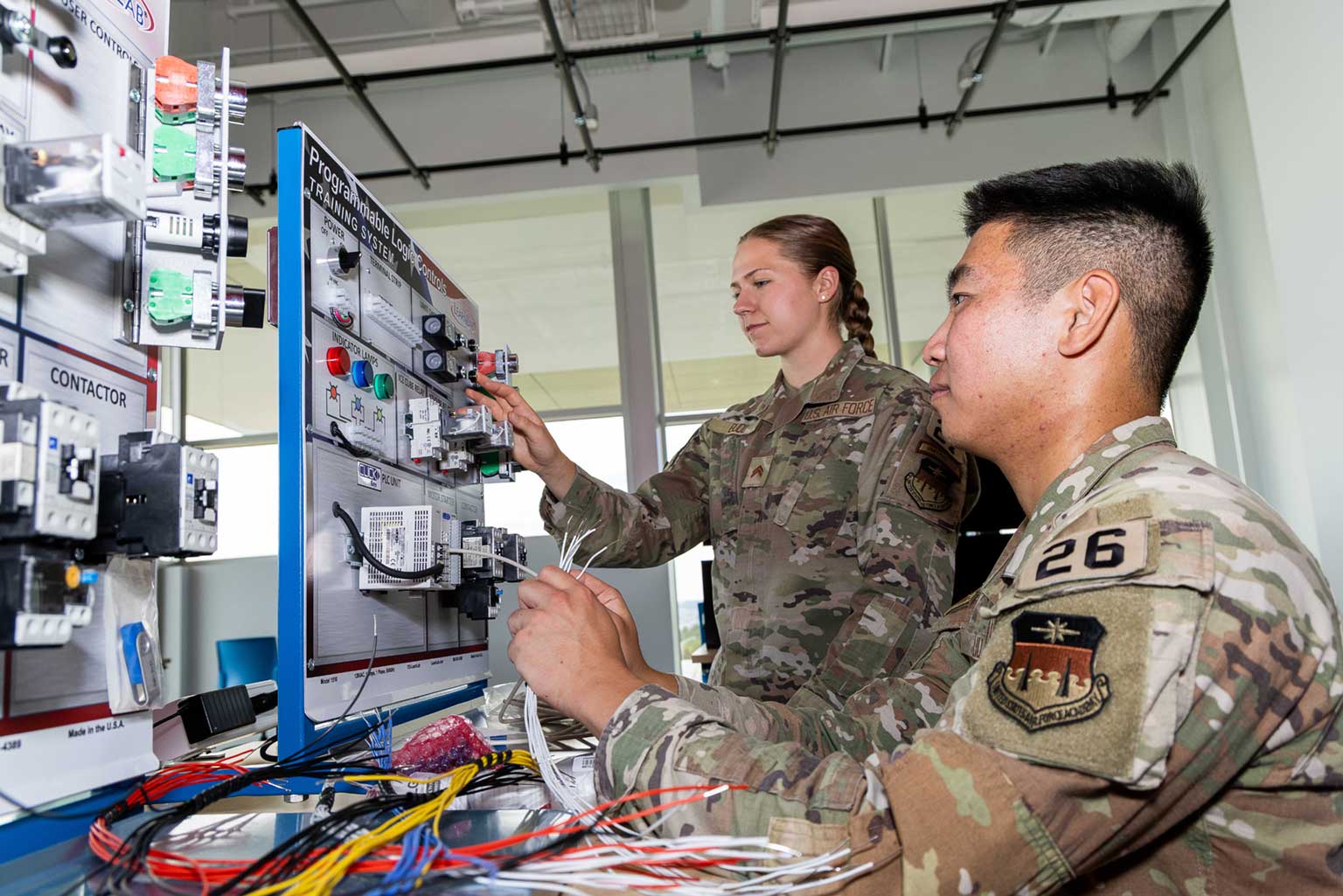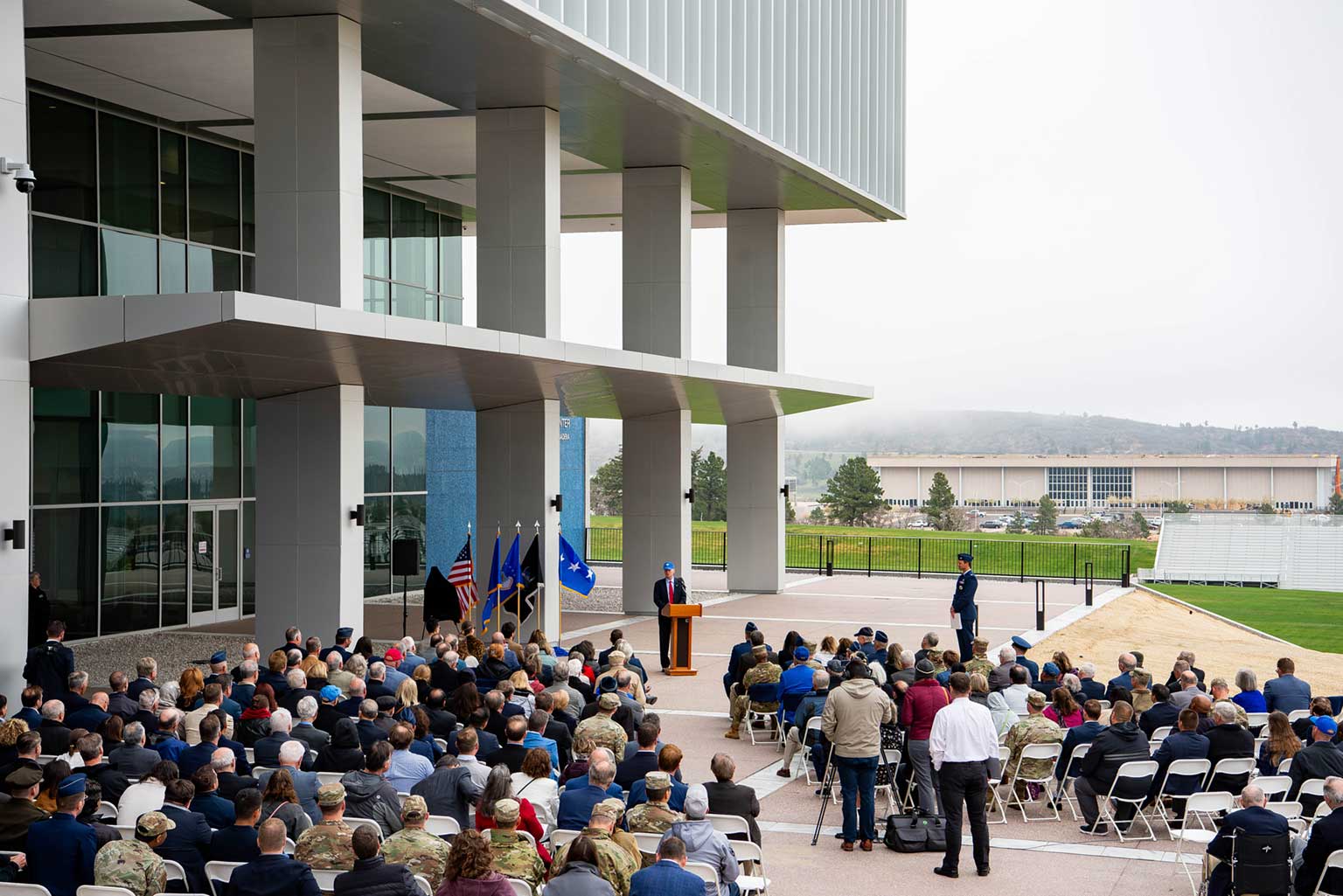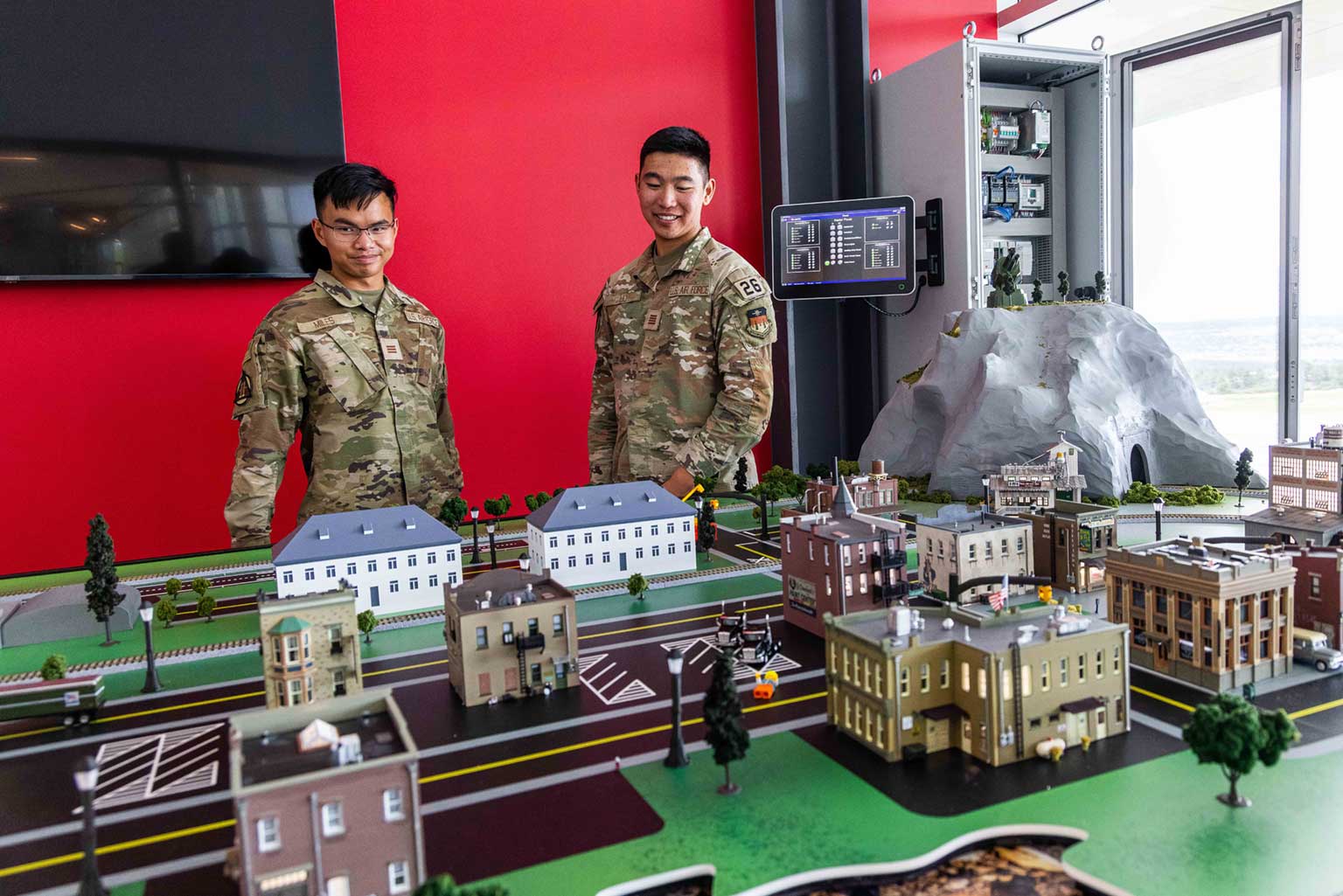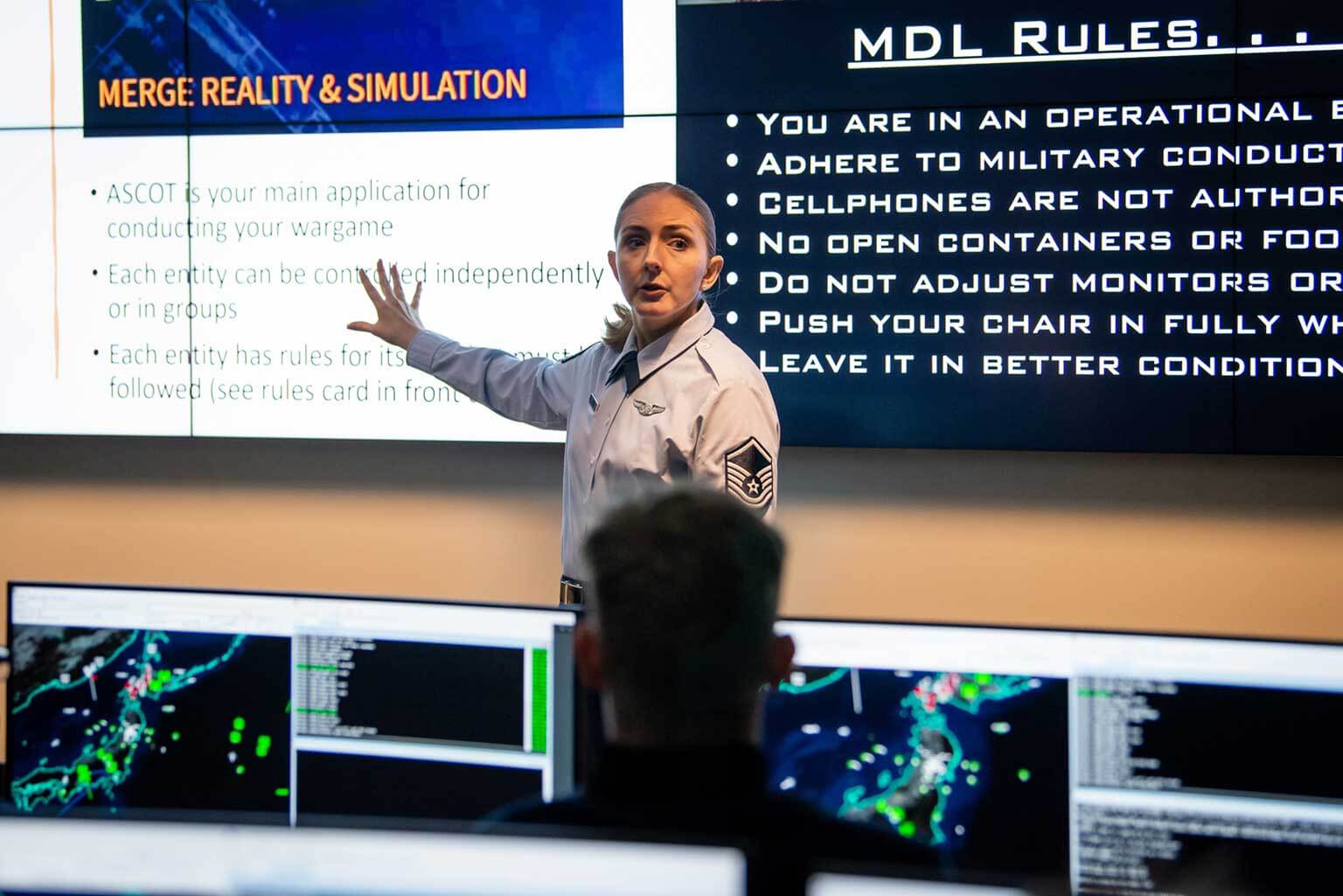A comprehensive approach to developing a cyber mindset

Cadet 2nd Class Caitlyn Budd and Cadet 1st Class Jaden Liu look at a control panel in the Madera Cyber Innovation Center, U.S. Air Force Academy, Colo, Aug. 7, 2025. The panel is part of the Cross-domain Command and Control Lab where cadets develop a cyber mindset by learning how a user interface acts as a bridge to control a network’s functionality. (U.S. Air Force photo by Trevor Cokley)
By Sonie Rathbun
U.S. Air Force Academy Strategic Communications
U.S. AIR FORCE ACADEMY, Colo. – The U.S. Air Force Academy integrates cyber concepts into its curriculum to ensure every cadet develops a cyber mindset before commissioning. This comprehensive approach prepares future military leaders to navigate a world where digital threats are as significant as physical ones.
“General Allvin’s (Chief of Staff of the Air Force) vision of reoptimizing for Great Power Competition is our guiding principle,” said Lt. Col. James Maher, acting department head of Computer and Cyber Sciences. “We are training the next generation of warrior-leaders to master the digital domain, integrating real-world cyber and artificial intelligence to ensure the Air Force and Space Force are ready for modern and future warfare challenges.”
Foundational knowledge and specialized pathways
The Academy starts building a cyber mindset with a mandatory course for all four-degree cadets called “Introduction to Computing and Cyber Operations,” which provides a baseline understanding of cyber risks.
This foundational class is key to developing a cyber mindset from the start. Cadets can then pursue more advanced courses and cyber-focused majors and minors.
“Every cadet, regardless of their major, must understand the fundamentals of cyberspace,” Maher said. “Our goal is not just to produce cyber operators, but to ensure that every Air Force and Space Force officer is equipped to operate in the cyber domain and include that domain in all military operations.”
Cadet 1st Class Emile Olivier, a cyber science major, emphasized the real-world connection.
“The cyber opportunities at the Academy are truly unique,” said Olivier. “From our classes to the hands-on experience in labs and operations centers, we can see a direct connection between our daily coursework, hands-on learning and national defense.”

The Madera Cyber Innovation Center officially opened with a ribbon-cutting ceremony at the U.S. Air Force Academy, Colo., April 25, 2025. The three-story, 48,000-square-foot facility will serve over 1,400 cadets annually, helping them develop a cyber mindset and preparing them to plan and execute multi-domain operations in a dynamic environment. (U.S. Air Force photo by Dylan Smith)
State-of-the-art facilities and collaborative research
The Academy is at the forefront of cyber education with state-of-the-art facilities like the recently opened Madera Cyber Innovation Center.
This three-story, 48,000-square-foot facility houses the Department of Computer and Cyber Sciences, the Institute for Future Conflict, and AF CyberWorx.
It features 14 unique laboratories and classrooms, including a sensitive compartmented information facility for real-world training.
Additionally, it provides cadets with an environment to collaborate with industry and military cyber experts.
“The coursework and technical skills I’m learning translate directly to our mission to defend the nation,” said Olivier. “We get to work with partners from the private sector, government, and military on senior capstone projects. We conduct research and deliver products that solve real defense-related problems and bolster these organizations’ security postures.”
The Madera Cyber Innovation Center brings together academia, industry and the military to solve complex problems. This collaborative approach is central to the Academy’s mission of preparing cadets for the complex challenges of modern warfare.
“The collaboration between the Academy, AF CyberWorx, and the Institute for Future Conflict is central to the goal of increasing cadet research in cybersecurity and artificial intelligence, preparing them for future conflicts that our nation may face,” said Maher.

Cadet 1st Class Ian Miles and Cadet 1st Class Jaden Liu use the Cyber City diorama to learn how cyber-attacks can affect critical infrastructure, U.S. Air Force Academy, Colo., Aug. 7, 2025. This hands-on experience helps develop a cyber mindset that extends beyond network defense to include the ethical and operational complexities when a city suffers a cyberattack. (U.S. Air Force photo by Trevor Cokley)
Cyber City training
One of the Madera Cyber Innovation Center’s key features is the Cyber City diorama, which simulates industrial control systems in a modern city.
Four-degree cadets tour Cyber City to develop a cyber mindset and understand the impact of cyberwarfare on critical infrastructure. Upper-class cadets majoring in cyber and computer sciences use the diorama in their classes to respond to simulated cyberattacks on power grids and other essential services.
“Training on Cyber City changed how I think about cyberattacks,” said Cadet 1st Class Jaden Liu, a cyber science major. “Before, it was all about code and firewalls. But during the simulation, you see how an attack on the power grid could shut down a hospital or a water treatment plant, making you realize the human impact of a cyber-attack. It’s not just about defending networks; it’s about protecting people’s lives and essential services.”

Master Sgt. Bonnie Rushing, a Department of Military and Strategic Studies professor, instructs cadets on multi-domain operations at the U.S. Air Force Academy, Colo., March 21, 2023. All cadets use the multi-domain lab to learn the fundamentals of warfare, develop a cyber mindset for military planning, and practice multi-domain effects in a dynamic joint environment. (U.S. Air Force photo by Justin Pacheco)
Training in multi-domain warfare
While the Madera Cyber Innovation Center provides an immersive look into cyber-physical systems, the Multi-Domain Lab (MDL) offers a different type of immersive training.
The MDL is a 7,000-square-foot facility that provides cadets with a high-fidelity, unclassified simulated battlespace. It integrates over 60 layers of software with state-of-the-art user interfaces.
Cadets use the lab to develop a cyber mindset in the context of military planning across all domains, learn the fundamentals of warfare, and employ multi-domain effects in a dynamic joint landscape.
“My biggest takeaway from using the multi-domain laboratory was teamwork,” Liu said. “I saw how integrating different roles—from air combat to cyber—is essential for a mission’s success.”
Academic pathways prepare cadets for complex challenges
For those interested in the cyber domain, the Academy offers a variety of specialized majors and minors to develop a pipeline of technical experts. Cadets can choose from several cyber-aligned majors, including Computer Science, Cyber Science, Data Science, Electrical and Computer Engineering, Operations Research, and Systems Engineering. Additionally, cadets can pursue a minor in High-Performance Computing or Quantum Technologies.
These academic pathways prepare cadets for complex challenges in a digital world, a sentiment echoed by those currently in the program.
“Approaching challenges is critical for all cyber students, who must stay one step ahead of evolving threats,” said Cadet 2nd Class Caitlyn Budd, a cyber science major. “The cyber domain is rapidly changing, and in future conflicts, has the potential to dictate the upper hand. My education has enabled me to receive hands-on experience in a controlled simulation before facing real-world problems once I am commissioned.”
See more cyber science photos on Flickr.